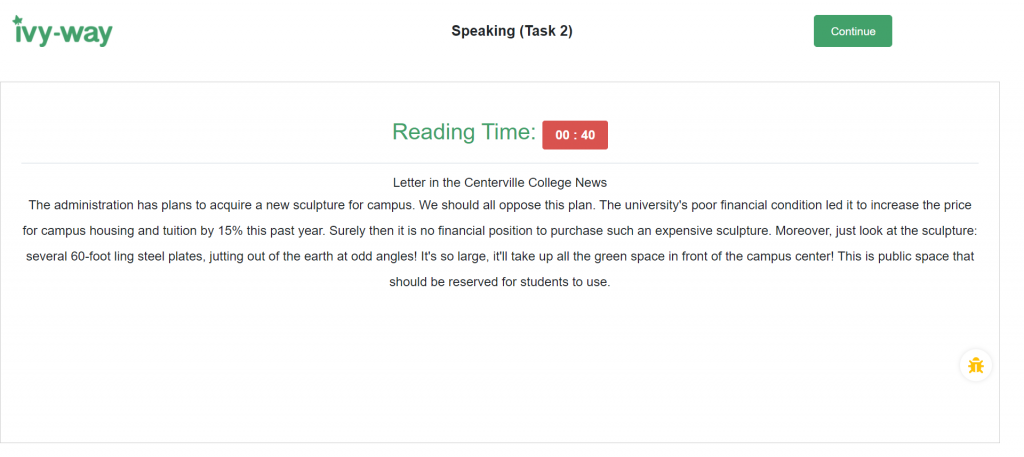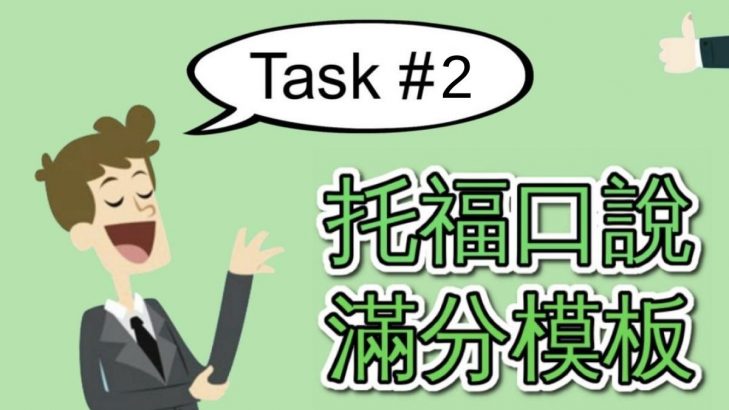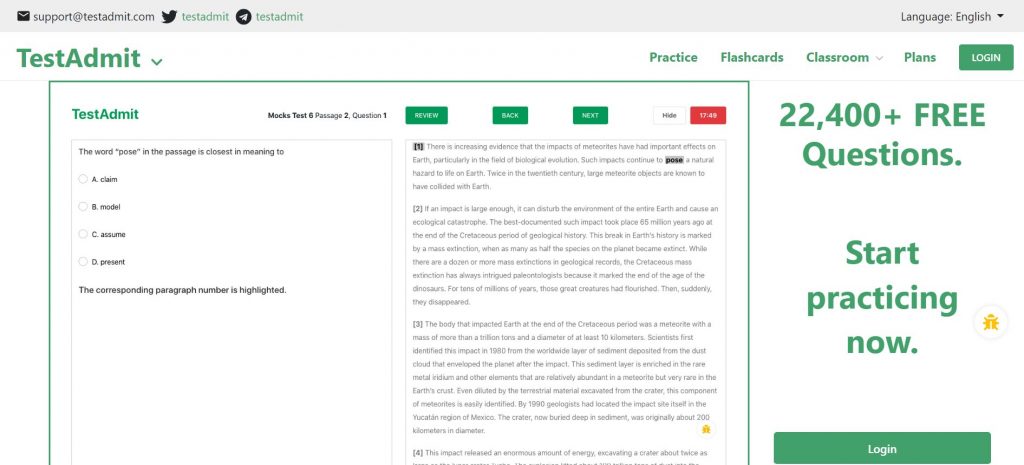很多考生會覺得托福口說是整份托福考試中最難的,因為學生必須在 1 分鐘之內準備並說出答案,而且只有一次機會。這對不擅長說英文的亞洲學生來說是一個很大的壓力。
繼上次分享托福口說第 1 題模板後,很多人來敲碗,希望我們也可以分享第二題的模板和範例。話不多說,讓我們來看看要如何準備,以及有哪些答題技巧吧!
托福口說 Task 2 在考什麼?
托福口說第二題又稱為「Integrated speaking Task」(綜合口說題),題目通常需要先閱讀一段短文,內容多半圍繞在校園情況,像是提案或公告。閱讀文章有 50 秒的時間限制,考生需要在閱讀文章的同時做筆記,因為文章只會出現一次無法重新閱讀。
閱讀完短文後,接下來會再聽到一段對話,同樣需要做筆記,因為錄音檔只會播放一次。
最後,你會看到一個題目,提示可能會要求你完成不同的任務。考生必須在 60 秒或更短的時間內完成這些任務,請注意,這並不代表你必須說滿 60 秒,而是只要能達成任務就可以。

問題提示
首先,我們想先從一個最典型的問題提示開始談起。在測驗中,考生必須先閱讀文章和聆聽對話後才會看到問題,但是問題的邏輯通常是大同小異的,只要了解大致的架構,你就可以在閱讀跟聽力時優先準備。舉例:
The woman expresses her opinion of the proposed policy change. Briefly summarize the policy change. Then, state the woman’s opinion, and explain the reasons she gives for holding that opinion.
上述的問題提示要求應試者完成三個不同的任務:
- 任務一:簡單總結(閱讀)
- 任務二:描述說話者意見(聽力)
- 任務三:解釋原因(閱讀+聽力)
但並不是所有題目都會要求考生完成這三個任務。有些題目不會要求學生總結大綱;有些題目則在問題中就已經提供說話人的意見,因此無須陳述意見;有些問題只要求解釋原因。因此你會遇到什麼類型的問題,只有考試當天才會知道。
儘管在測驗時,你可能幸運地不需要一次完成三項任務,但我們還是建議你要準備完全。畢竟你是先經過閱讀和聽力的關卡後才能看到問題,而且都只有一次機會,因此多準備總是比少準備好。
接下來,我們將會針對第二題的閱讀、聽力、如何回答及分數部分進行詳細解說。
閱讀段落
典型的閱讀段落包含兩個主要部分,第一部分是計畫或提案的內容,第二部分是針對計畫或提案的討論,有時候也可能是闡述計畫或提案的好處。
以下是一個比較經典的閱讀段落範例:
University to Prohibit Bicycles on Campus
Beginning next semester, the University will not allow the use of bicycles on campus. The campus sidewalks are intended for pedestrians and receive heavy pedestrian traffic. Several minor accidents have resulted from people on bicycles colliding with people walking, and although no one has been seriously hurt, University officials feel that bicycles pose a safety risk. Furthermore, the prohibition of bicycles will not be a problem for students, since the university currently operates a convenient alternative: the free campus bus system, which runs between all campus buildings.
你必須紀錄計畫或提案的主要內容,這通常可以在標題或文章前幾行就找到。以上面這篇文章為例,第一句話就是這個計畫最主要的目的:
“Beginning next semester, the University will not allow the use of bicycles on campus.”
這個資訊就是你完成任務一「簡單總結」的關鍵,由於這句話會需要出現在你的答案中,因此我們強烈建議你把它寫下來。另外,這也是一個紀錄關鍵字詞的機會,例如你看到「not allow」時可能會聯想到「prohibit (禁止)」這個字。
文章的其他內容則是在描述原因和(或)好處,這些也是你必須記錄下來的,如果遇到問題三「解釋原因」時,就可以利用這些資訊。例如,我們會這樣寫:
- “bicycles pose a safety risk”
- “the prohibition of bicycles will not be a problem for students”
聽力對話
閱讀完文章後,緊接著會進入聽力部分,考生需要聆聽兩位學生之間的對話。這兩位說話者同樣也剛閱讀完上面那則提案或公告,而他們正要針對內容進行討論。
通常,第一位學生會詢問第二位學生的意見。這時我們知道它屬於任務二「描述說話者意見」的範疇,所以請務必仔細聆聽並記錄下來。
隨著對話繼續延伸,說話者也會討論到文章中提到的原因和(或)好處,並提出他們的意見。這邊的內容則會幫助你完成任務三「解釋原因」。
以下是一個典型的聽力對話腳本(當然,在考試中你不會看到完整的對話內容,只能聆聽對話),請仔細觀察女性說話者的意見,以及對原因和(或)好處的反應:
(man) Hey, Sue, did you see this article?
(woman) Yeah, I did, and I don’t think that’s a very good idea.
(man) Really? You don’t think it’s a safety hazard like they said?
(woman) No, at least not during the day. I’m pretty sure both of those accidents happened at night when it’s harder to see cyclists. They didn’t say that in the article
(man) Oh, that does make a difference.
(woman) Sure, it does. Maybe at night with low visibility there’s a safety hazard but I don’t think there’s any danger in the daytime which is when most people need to move around and get to classes.
(man) Yeah, that makes sense.
(woman) Besides, it’s such a big campus… if they do this, it’s going to be really hard to get around.
(man) Well, we could always take the bus, I guess.
(woman) But the buses only run once an hour.
(man) That’s true. They’re not very convenient.
(woman) No, not at all. If people have to take the bus, we’ll end up sitting around waiting for the next one all the time and we’re all too busy to waste our time doing that.
女性說話者的意見傳達得非常清楚:“I don’t think that’s a very good idea”。同時,她也對公告中的兩個原因做出反應,她並不同意自行車是一種安全隱患,至少在白天的時候不是如此;此外,她也不認為禁止學生騎自行車不會造成問題,這也是她堅持自己不同意觀點的原因。
高分回答的結構分析
接下來,你就會看到題目,並利用 30 秒的時間準備自己的回答。在這 30 秒內,你必須檢視自己剛才寫下來的筆記,然後標示先後回答順序,像是直接寫下數字 1、2、3。
這是一個我們建議的範例:
Task One: Beginning next semester, the University will not allow the use of bicycles on campus… prohibit bicycles…
Task Two: She doesn’t think it’s a very good idea.
Task Three: Reasons
1. She disagrees that “bicycles pose a safety risk…”
2. She disagrees that “the prohibition of bicycles will not be a problem for students…”
有了上面這些基本資訊後,你應該就能掌握 task 2 任何一種問題版本。以下是在考試時,你可能會遇到各種版本的範例:
Version 1: The woman does not think the university’s policy change is a good idea. Explain the reasons she gives for holding that opinion.
Version 2: The woman expresses her opinion of the policy change. State the woman’s opinion and explain the reasons she gives for holding that opinion.
Version 3: The woman expresses her opinion of the proposed policy change. Briefly summarize the policy change. Then, state the woman’s opinion, and explain the reasons she gives for holding that opinion.
重點來了,如果你希望在這一題獲得高分,那麼你一定要按照題目說的去做。例如,如果你要回答版本 1,你花了 30 秒闡述政策是如何改變和女性說話者的意見,那麼你就浪費了 30 秒;如果是版本 3,你則必須按照順序完整回答這三個問題,才有機會拿到高分。
假設你拿到的是版本 3 的題目,雖然沒有一個正確回答問題的架構,但只要按照問題出現的順序去思考你的答案就夠了。
現在,讓我們來分解一個高分答案需要完成的任務:
任務一:簡單總結
架構:“According to the reading passage, [summary of the passage].”
例句:“According to the reading passage, the university is going to prohibit the use of bicycles on campus beginning next semester.”
這句話簡單精要地描述政策發生哪些變化,任務一就算完成了。
任務二:描述說話者意見
架構: “The woman [her opinion in her exact words]”
例句 1:“The woman doesn’t think that it’s a very good idea…“
例句 2:“The woman [thinks that it’s a very good idea…]”
請注意,這裡我們用「女性說話者」的句子來描述她的意見,“[doesn’t] think that it’s a very good idea”,寫下你所聽到的內容並把它說出來是最簡單的,因為你不需要考慮其他用詞,並且可以確定你的回應將能準確表達女性說話者的意見。如果你改變用詞,你可能會不小心改變了女性說話者的意見,造成分數降低。
很多時候,學生可能總是對每個回答使用“opposes”、“disagrees” 或 “contradicts” 等字詞。這可能是有風險的,因為女性說話者並不總是反對或不同意。
舉例,在這個題目中,說 “the woman contradicts” 是不對的,但是說 “the woman disagrees” 卻是正確的。因此,直接引用女性說話者使用的字詞是最安全的。
任務三:解釋原因
架構:The woman disagrees with/that [reason/benefit from the reading passage].
例句 1:First, she disagrees with the explanation presented in the reading passage…
例句 2:She also disagrees with the second point made in the passage…
在這裡,答案不僅只是總結女性說話者的意見,因為問題要求我們「解釋」。請注意,說話者也是剛看完公告後就做出反應,因此我們要解釋她看完公告後為什麼會有這樣的反應。
口說 task 2 高分回答的範例
上面這個答案會是一個可以拿到高分的答案,為什麼?因為它準確完成了問題提示中所有的任務,現在讓我們看看完整答案可能的樣子:
According to the reading passage, the university is going to prohibit the use of bicycles on campus beginning next semester. The woman doesn’t think that it’s a very good idea for two reasons. First, she disagrees with the explanation presented in the reading passage that bicycles pose a safety risk, at least during the day, although she did think that it might make sense at night because of lower visibility. She also disagrees with the second point made in the passage that the prohibition will not be a problem for students. In fact, she thinks that it will be a problem because, although there are buses on campus, there is only one bus per hour. This will be inconvenient for students and cause them to waste a lot of time waiting for buses.
如你所見,如果你希望在口說第二題上取得好成績,那麼關鍵在於做好筆記,並且仔細閱讀題目賦予的任務是哪些。當你在回答問題時,請記得完整地總結、描述和解釋原因,並且考試前多練習幾次,就有機會拿到高分喔!
托福口說要如何練習?
我們建議學生多利用 TestAdmit 做免費的口說考題,透過免費的托福官方真題,學生可以體驗不同的托福口說題目,嘗試把我們提供的模板應用在自己的答案裡:
托福口說要補習嗎?怎麼補習效果會最好?
在正常情況下,我們不太推薦學生報名團體托福口說課,因為市面上的大班托福課內所上的內容可以被很多免費的 YouTube 口說教學課取代,另外,其實只要學生依照我們提供的模板多加練習,其實就可以得到非常大的進步了。
如果還是卡關不行的話,我們建議學生報名 Ivy-Way 的一對一托福口說精華課,針對學生口說的弱點對症下藥,正常情況下只需要 1-2 堂課就可以拿到口說的 25-28 分喔!

